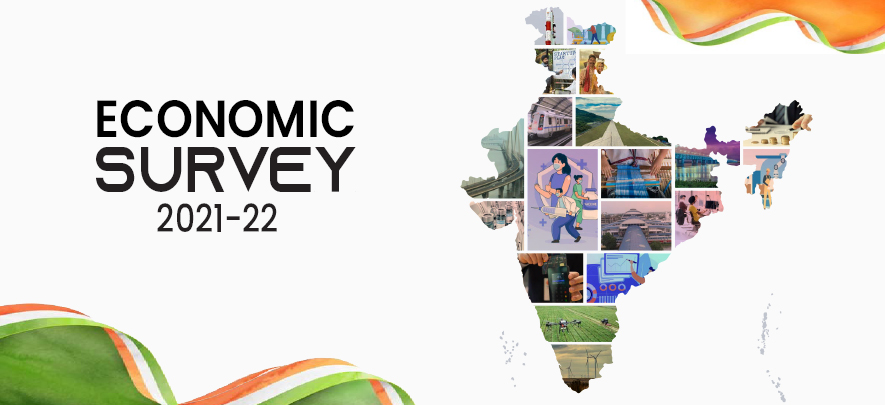Highlights of Economic Survey 2021-22

Economy
153 week ago — 7 min read
The Economic Survey is an annual document prepared by the Ministry of Finance under the guidance of the Chief Economic Advisor. Economic Survey is much like an annual report card of the economy which explores the performance of each and every sector and suggests future reforms. This document is typically presented by the Finance Minister a day before the Union Budget and this provides vital context to the budget
Highlights from Economic Survey 2021-22
For second year running, the Economic Survey was written under the cloud of the Covid-19 pandemic. It is not just about the immediate disruptions and uncertainty caused by repeated waves of the pandemic, but also the longer-term uncertainty about the post-Covid world due to accelerated shifts in technology, consumer behaviour, supply-chains, geo-politics, climate change and a host of other factors. The theme of this Economic Survey, therefore, relates to the art and science of policymaking under conditions of extreme uncertainty.
GDP
Advance estimates suggest that the Indian economy is expected to witness real GDP expansion of 9.2 per cent in 2021-22 after contracting in 2020-21. This implies that overall economic activity has recovered past the pre-pandemic levels.
Agriculture
Agriculture and allied sectors have been the least impacted by the pandemic and the sector is expected to grow by 3.9 per cent in 2021-22 after growing 3.6 per cent in the previous year.
Industrial Sector
The industrial sector went through a big swing by first contracting by 7 per cent in 2020-21 and then expanding by 11.8 per cent in this financial year. The manufacturing, construction and mining sub-sectors went through the same swing although the utilities segment experienced a more muted cycle as basic services such as electricity and water supply were maintained even at the height of the national lockdown.
Services Sector
The Services sector has been the hardest hit by the pandemic, especially segments that involve human contact. This sector is estimated to grow by 8.2 per cent this financial year following last year’s 8.4 per cent contraction. Both the Finance/Real Estate and the Public Administration segments are now well above pre-COVID levels. However, segments like Travel, Trade and Hotels are yet to fully recover. It should be added that the stop-start nature of repeated pandemic waves makes it especially difficult for these sub-sectors to gather momentum.
Construction Sector
Rising capital expenditure by the government on infrastructure and an uptick in the housing cycle have been responsible for reviving the construction sector. This has allowed the consumption and production of steel and cement consumption to revert to pre-COVID levels. Statistics provided by RBI and leading real estate companies’ show significant revival in the Indian residential real market in 2021 in terms of growth in sales, prices and new launches
Exports
Exports of both goods and services have been exceptionally strong so far in 2021-22, but imports also recovered strongly with recovery in domestic demand as well as higher international commodity prices. Merchandise exports have been above US$ 30 billion for eight consecutive months in 2021-22, despite a rise in trade costs arising from global supply constraints such as fewer operational shipping vessels, exogenous events such as blockage of Suez Canal and COVID-19 outbreak in port city of China etc. ). Concurrently, net services exports have also risen sharply, driven by professional and management consulting services, audio visual and related services, freight transport services, telecommunications, computer and information services.
Total Consumption
Total Consumption is estimated to have grown by 7.0 per cent in 2021-22 with significant contributions from government spending. Similarly, Gross Fixed Capital Formation exceeded pre-pandemic levels on the back of ramped up public expenditure on infrastructure.
Inflation
Inflation has reappeared as a global issue in both advanced and emerging economies. India’s Consumer Price Index inflation stood at 5.6 per cent YoY in December 2021 which is within the targeted tolerance band. Wholesale price inflation, however, has been running in double-digits. Although this is partly due to base effects that will even out, State of the Economy 3 India does need to be wary of imported inflation, especially from elevated global energy prices.
Supply Side Reforms
Another distinguishing feature of India’s economic response has been an emphasis on supply-side reforms rather than a total reliance on demand management. These supply-side reforms include deregulation of numerous sectors, simplification of processes, removal of legacy issues like ‘retrospective tax’, privatisation, production-linked incentives and so on.
The emphasis given to the supply-side in India’s COVID-19 response is driven by two important considerations. First, Indian policy-makers saw the disruptions caused by travel restrictions, lockdowns and supply-chain breakdowns as an interruption of the economy’s supply-side. Although this also squeezed demand, it is not correct to see the pandemic related economic slowdown as just a demand problem as happens with most economic cycles. Second, the post-Covid world will be impacted by a wide variety of factors – changes in technology, consumer behaviour, geo-politics, supply-chains, climate change and so on. All of these factors will also interact in unpredictable ways with each other. Therefore, the post-Covid economy will not be merely a re-inflation of the pre-Covid economy. Simply building it back with demand measures is not a solution.
Source: Economic Survey 2021-22
GlobalLinker recently conducted a webinar where a seasoned Chartered Accountant & Tax Expert shared insights on how Budget 2022 impacts MSMEs. Watch the highlights below.
Disclaimer: The views and opinions expressed in this article are those of the indicated source and do not necessarily reflect the views, official policy or position of GlobalLinker.
Posted by
GlobalLinker StaffWe are a team of experienced industry professionals committed to sharing our knowledge and skills with small & medium enterprises.
Most read this week
Trending
Ecommerce 1 day ago
















Comments
Please login or Register to join the discussion